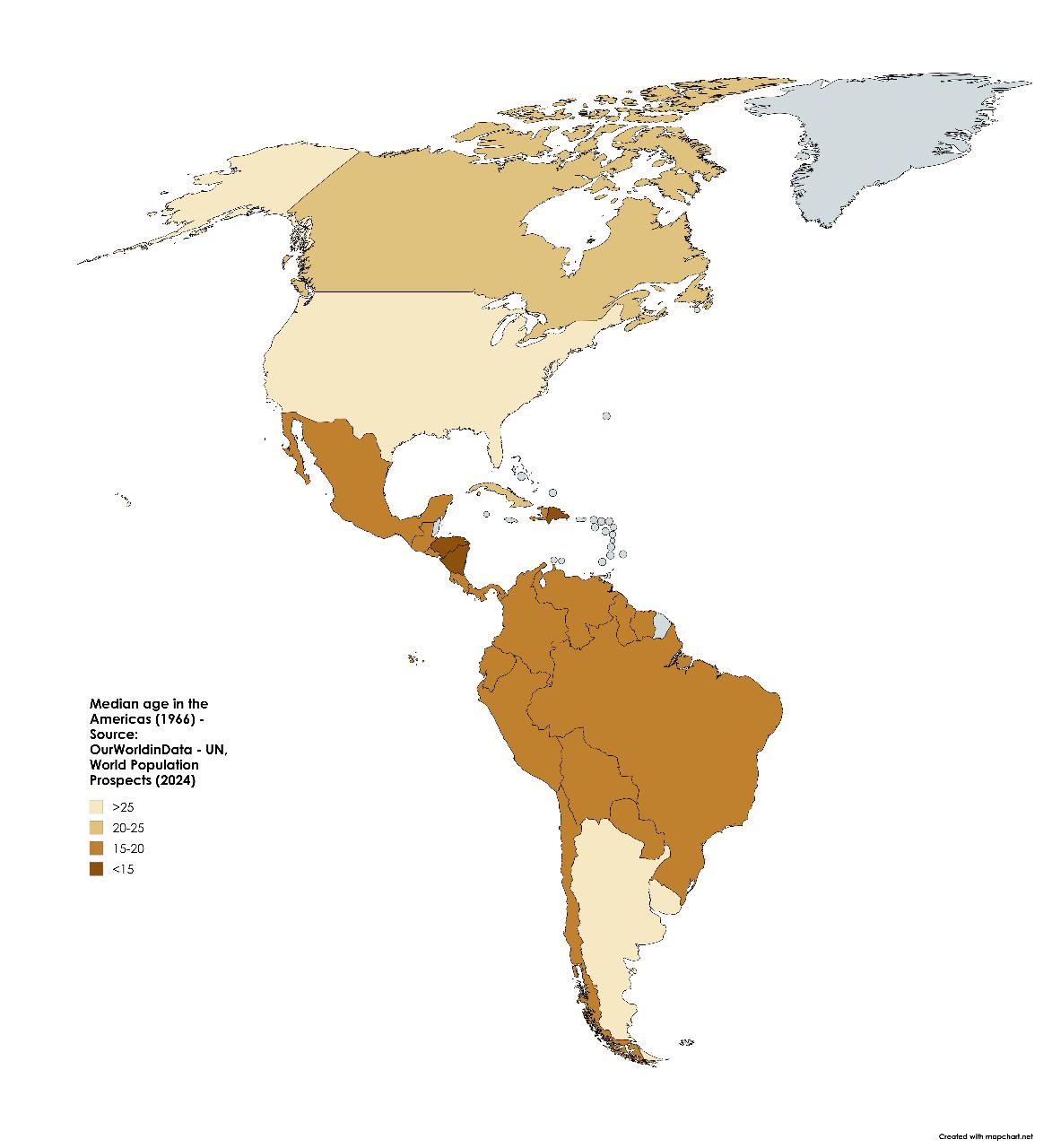Median Age in the Americas Map 1966


David Chen
Data Visualization Specialist
David Chen is an expert in transforming complex geographic datasets into compelling visual narratives. He combines his background in computer science ...
Geographic Analysis
What This Map Shows
The visualization of median age in the Americas in 1966 provides a striking snapshot of demographic trends across the continent. This map highlights how the population's median age varied significantly, reflecting the socio-economic conditions of different countries during that era. In general, most nations in the Americas had a median age of less than 20 years, indicative of youthful populations, whereas more developed countries like Argentina, the United States, Canada, and Uruguay showcased median ages exceeding 20 years. This disparity reveals much about the developmental stages of these nations at the time, setting the stage for deeper exploration into population dynamics.
Deep Dive into Median Age Dynamics
Median age is a crucial demographic indicator that offers insights into the age structure of a population. It serves as a reflection of a country’s fertility rates, mortality rates, and migration patterns. In 1966, the Americas were characterized by a predominantly young population. For instance, many Central American countries, including Guatemala and Honduras, exhibited median ages below 15 years. This suggests high birth rates and lower life expectancy, factors often tied to developing nations.
Interestingly, the youthful demographics in these nations can be attributed to various historical and socio-economic factors. High fertility rates were common, often influenced by limited access to education and healthcare, particularly for women. In many cases, families relied on larger numbers of children for economic support, especially in agrarian societies.
On the other hand, countries like the United States and Canada, with median ages around 28 and 25 years respectively, reflected more advanced economic conditions. These nations had lower fertility rates, improved healthcare, and a higher standard of living, contributing to longer life expectancies. The post-World War II baby boom also played a significant role in shaping the age distribution during this period. The economy was booming, and families were more inclined to have children, leading to a temporary spike in median age figures.
Moreover, Argentina and Uruguay, which also had median ages above 20 years, were experiencing urbanization and industrialization. This transition often leads to demographic shifts as rural populations move to cities, where economic opportunities are more abundant, and family sizes typically decrease. The combination of these factors illustrates how economic development can influence population structures.
Regional Analysis
Examining the map reveals distinct regional patterns in median age across the Americas. In the Caribbean, for instance, countries like Cuba had a median age of approximately 25 years, showcasing a balance between youthful demographics and signs of development, contrasted with nations like Haiti, where the median age fell below 20 years. This reflects Haiti's ongoing struggles with poverty and health crises, hindering demographic progress.
In South America, Brazil showcased a median age of around 21 years. The country was in the midst of significant social transformation, with urbanization beginning to take hold. Meanwhile, Chile, with a median age of 25 years, was also on a path to modernization, yet still faced challenges associated with uneven economic development. It’s fascinating to see how regional policies and socio-economic conditions can lead to such variations in median age even within neighboring countries.
Significance and Impact
Understanding median age is essential for several reasons. It provides insights into the labor market, healthcare needs, and educational requirements of a population. A youthful population can signify a future labor force ready to contribute to economic growth, but it also poses challenges in terms of education and employment opportunities. Countries with higher median ages, conversely, may face issues related to an aging population, such as increased healthcare demands and pension sustainability.
Looking back to 1966 allows us to appreciate how far the Americas have come and the demographic shifts that have occurred since then. Today, many of these nations are experiencing aging populations, with median ages rising as birth rates decline and life expectancy increases. The implications of these demographic trends are profound, affecting everything from economic policy to social services.
Have you noticed how these shifts can influence contemporary issues like immigration policy and workforce development? As we look toward the future, understanding these historical contexts will be crucial for navigating the complexities of demographic change in the Americas and beyond.
Visualization Details
- Published
- October 18, 2025
- Views
- 36
Comments
Loading comments...